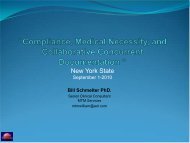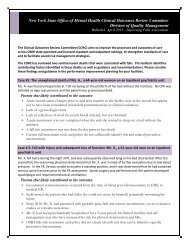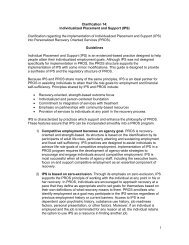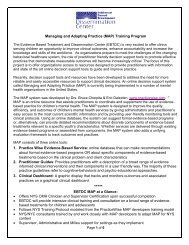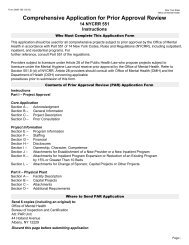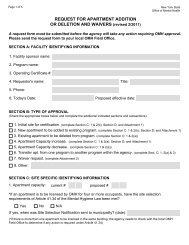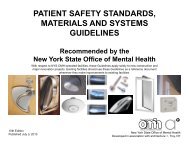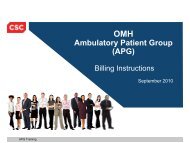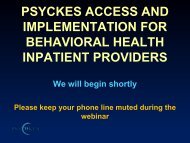Download - New York State Office of Mental Health
Download - New York State Office of Mental Health
Download - New York State Office of Mental Health
Create successful ePaper yourself
Turn your PDF publications into a flip-book with our unique Google optimized e-Paper software.
Saving Lives in <strong>New</strong> <strong>York</strong> Volume 2: Approaches and Special Populations<br />
• Stigma <strong>of</strong> mental health treatment<br />
• Medical personnel receive little or no<br />
training in identifying PPD<br />
• Family members may fail to recognize<br />
PPD<br />
• Mothers may not seek treatment due to<br />
lack <strong>of</strong> energy caused by the illness,<br />
stigma and/or feeling guilty about<br />
being depressed when she is supposed<br />
to be “happy.”<br />
II. Current <strong>State</strong> Efforts<br />
• The <strong>Health</strong>y Families <strong>New</strong> <strong>York</strong> (HFNY)<br />
program provides home visiting services<br />
by trained home visitors who work with<br />
expectant families and families with<br />
newborns who have certain risk factors<br />
that may lead to child abuse and neglect<br />
and poor health outcomes. Home Visitors<br />
provide weekly home visits until the<br />
child is at least six months old and may<br />
continue less frequently based on the<br />
needs <strong>of</strong> the family until the child is five<br />
years old or in school or Head Start. Visits<br />
are aimed at promoting positive parent-child<br />
interaction and optimal child<br />
health and development. Home visitors<br />
also assist in linkage to other services to<br />
increase the families’ self-sufficiency.<br />
The HFNY program is currently located<br />
in 28 sites serving high need areas<br />
across the state.<br />
• Association <strong>of</strong> Perinatal Networks <strong>of</strong><br />
<strong>New</strong> <strong>York</strong> received a grant to create<br />
training programs and resources to<br />
increase awareness <strong>of</strong> PPD and<br />
increase service utilization.<br />
• Information on PPD has been added to<br />
the Maternity Information leaflet, disseminated<br />
to all obstetrical hospitals<br />
statewide, and to “Your Guide to a<br />
<strong>Health</strong>y Birth,” which is also available<br />
to pregnant women statewide.<br />
• The Pregnancy Risk Assessment Monitoring<br />
System (PRAMS), a national<br />
screening program, now includes a<br />
question on PPD.<br />
• A prenatal depression question was<br />
added to the <strong>State</strong>wide Perinatal Data<br />
System.<br />
III. Action Steps<br />
1. There are strong risk factors for postpartum<br />
depression (PPD), and prenatal/perinatal<br />
screening can help to<br />
identify those most likely to develop it<br />
as well as deliver services to them in<br />
the hospital with follow-up to start right<br />
after delivery. Obstetricians, pediatricians<br />
and other medical personnel in<br />
contact with new mothers should<br />
screen mothers for PPD during the<br />
child’s first year.<br />
2. Home visiting services have been<br />
shown to be effective in improving outcomes<br />
for children. All at-risk new<br />
mothers should receive home visitations<br />
services and be screened for postpartum<br />
depression, including follow-up<br />
care for women who screen positive<br />
and an emergency protocol for women<br />
in a peri-suicidal state or homicidal<br />
state. Involvement <strong>of</strong> the new mother’s<br />
partner or support person in their treatment<br />
is highly desirable.<br />
3. A media campaign that highlights the<br />
prevalence and risk factors for postpartum<br />
depression, linkages to service<br />
providers and training inevidencebased<br />
treatment for post-partum<br />
depression are necessary ingredients <strong>of</strong><br />
a prevention program.<br />
References<br />
American Association <strong>of</strong> <strong>Health</strong> Plans: Current Issues Report,<br />
Approaches to Depression Care. Washington, DC; AAHP,<br />
2000.<br />
American College <strong>of</strong> Obstetricians and Gynecologists, Answers to<br />
Common Questions about PPD. January 2002.<br />
www.acog.org<br />
Georgiapoulos, AM, Bryan, TL; Wollan, P; Yawn, BP. Routine<br />
Screening for PPD Journal <strong>of</strong> Family Practice, 50 (2), 2001.<br />
Moline, ML; Kah, DA; Ross, RW; Altshuler, LL; Cohen, LW. PPD: A<br />
Guide for Patients and Families, Expert Consensus<br />
Guideline Series. A Postgraduate Medicine Special Report,<br />
March 2001, 112-113.<br />
Sobey, WS, Barriers to PPD Prevention and Treatment: A Policy<br />
Analysis Journal <strong>of</strong> Midwifery & Women’s <strong>Health</strong>, Vol.47,<br />
no.5, Sept/Oct. 2002, 331-336.<br />
90 <strong>New</strong> Mothers




